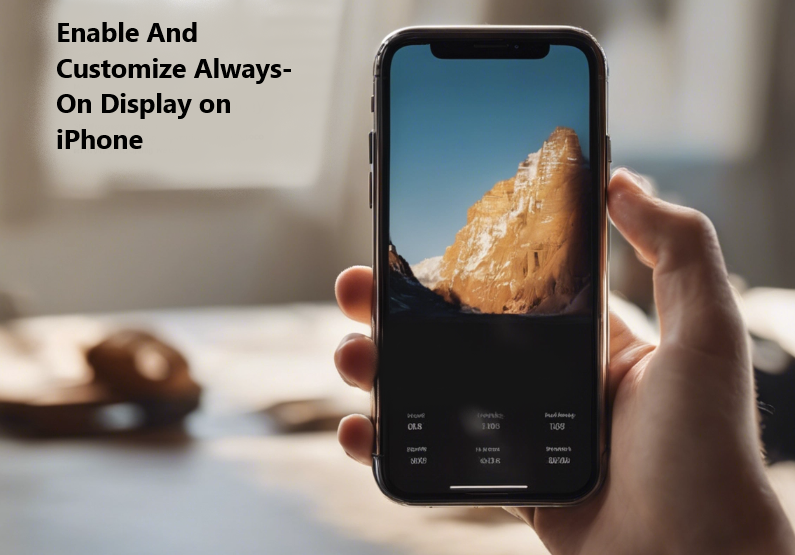The Always-On Display (AOD) on the iPhone changes how you stay informed. It shows important info like time, date, and notifications without waking your phone. This makes your iPhone more accessible and interactive. In this guide, we’ll show you how to turn on and customize the Always-On Display so you can get the most out of this feature.
Does iPhone Have Always-On Display (AOD)?
Yes, iPhones do have an Always-On Display (AOD) feature! However, it’s not available on all iPhone models. The AOD feature was first introduced with the iPhone X and is currently available on the following iPhone models:
- iPhone X Series
- iPhone 11 Series
- iPhone 12 Series
- iPhone 13 Series
- iPhone 14 Series
- iPhone 15 Series
Activating Always-On Display
Getting started with the Always-On Display on your iPhone is a breeze! This feature is available on select models like the iPhone 14 Pro and iPhone 15 Pro, bringing convenience to your daily routine. To activate it, follow these steps:
- Open Settings: Tap on the Settings icon on your mobile home screen.
- Display & Brightness: Scroll down and select Display & Brightness.
- Toggle On: Find the Always-On Display option and switch it on.
With a few clicks, your iPhone will now keep essential information visible at all times. Making it easier to stay informed without unlocking your device. Ready to customize it further? Let’s move on to the next section!
Read More:- How to Set Custom Ringtones on iPhone Without iTunes
Customizing Always-On Display
Now that you’ve activated the Always-On Display, it’s time to make it yours! Customizing this feature allows you to tailor what information is visible and how it looks, ensuring it fits into your daily life. Here’s how you can personalize your Always-On Display:
- Show Wallpaper: Decide whether you want your wallpaper visible on the Always-On Display. Head to Settings > Display & Brightness > Always-On Display and toggle the Show Wallpaper option.
- Show Notifications: Choose if you want notifications to appear on the Always-On Display. Navigate to Settings > Display & Brightness > Always-On Display and toggle the Show Notifications option.
- Focus Modes: Use Focus Modes to automate your Always-On Display settings based on your activities. For example, you can set it to show fewer details during work hours and more during personal time.
You can change how your Always-On Display looks to match your style, making it both helpful and aesthetically pleasing. Now, let’s talk about how to save battery while using this feature.
Battery Management
While the Always-On Display is a fantastic feature, it’s important to manage its impact on your iPhone’s battery life. Here’s how you can enjoy the benefits of Always-On Display without worrying about excessive battery drain:
- Impact on Battery Life: The Always-On Display uses little power to keep essential information visible. However, with efficient OLED technology, the impact is minimal.
- Battery-Saving Tips:
- Use Dark Wallpapers: Darker wallpapers consume less power on OLED screens, helping to conserve battery life.
- Enable Low Power Mode: If your battery is low, turn on Low Power Mode. This will reduce power consumption and dim the screen, extending your battery life.
- Adjust Brightness: Lowering the brightness of the Always-On Display can also help save battery. You can adjust this in Settings > Display & Brightness.
By following these tips, you can make the most of the Always-On Display feature while keeping your iPhone’s battery life in check. Let’s move on to the next section!
Troubleshooting Common Issues

Display Not Turning On
If your Always-On Display isn’t working, try these steps:
- Check Settings: Make sure that Always-On Display is enabled. Go to Settings > Display & Brightness > Always-On Display and turn it on.
- Disable Low Power Mode: Low Power Mode can disable the Always-On Display to save battery. Turn it off via Settings > Battery > Low Power Mode.
- Restart Your iPhone: A simple iPhone restart can resolve issues.
- Update iOS: Make sure that your iPhone is updated to the latest iOS version. Go to Settings > General > Software Update.
Read More:- What iPhones Are MagSafe Compatible?
Battery Drain
If Always-On Display is draining your battery excessively:
- Use Dark Wallpapers: Darker wallpapers consume less power on OLED screens, helping to conserve battery life.
- Enable Low Power Mode: If your battery is low, turn on Low Power Mode. This will reduce power consumption and dim the screen, extending your battery life.
- Adjust Brightness: Lowering the brightness of the Always-On Display can also help save battery. You can adjust this in Settings > Display & Brightness.
- Disable Unnecessary Notifications: To save battery, show fewer notifications on your iPhone’s screen when it’s locked.
If you follow these tips, you can use Always-On Display without hurting your iPhone’s battery
Additional Tips
- You can customize AOD by going to Settings > Display & Brightness > Always On Display. You can choose to show notifications on the lock screen, dim the display automatically in low-light conditions, and more.
- AOD can help you save battery life by reducing the number of times you need to wake up your iPhone’s display.
- If you’re concerned about privacy, you can disable AOD when your iPhone is locked.
Conclusion
Always-On Display (AOD) lets you see important things on your iPhone screen without waking it up. This guide helps you turn it on and make it look how you like. You can change settings, save battery, and fix problems. AOD makes it easy to see things quickly and enjoy your iPhone more. Try different settings on your iPhone to find what you like best.
Read More:- Why Are iPhones So Much Expensive Than Other High-End Smartphones?

